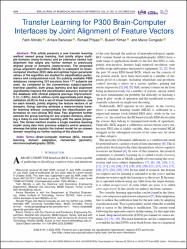| dc.contributor.author | Altindis, Fatih | |
| dc.contributor.author | Banerjee, Antara | |
| dc.contributor.author | Phlypo, Ronald | |
| dc.contributor.author | Yilmaz, Bulent | |
| dc.contributor.author | Congedo, Marco | |
| dc.date.accessioned | 2024-02-01T14:03:50Z | |
| dc.date.available | 2024-02-01T14:03:50Z | |
| dc.date.issued | 2023 | en_US |
| dc.identifier.issn | 2168-2194 | |
| dc.identifier.issn | 2168-2208 | |
| dc.identifier.other | WOS:001083127700007 | |
| dc.identifier.uri | https://doi.org/10.1109/JBHI.2023.3299837 | |
| dc.identifier.uri | https://hdl.handle.net/20.500.12573/1918 | |
| dc.description.abstract | This article presents a new transfer learning
method named group learning, that jointly aligns multiple domains (many-to-many) and an extension named fast
alignment that aligns any further domain to previously
aligned group of domains (many-to-one). The proposed
group alignment algorithm (GALIA) is evaluated on braincomputer interface (BCI) data and optimal hyper-parameter
values of the algorithm are studied for classification performance and computational cost. Six publicly available P300
databases comprising 333 sessions from 177 subjects are
used. As compared to the conventional subject-specific
train/test pipeline, both group learning and fast alignment
significantly improve the classification accuracy except for
the database with clinical subjects (average improvement:
2.12±1.88%). GALIA utilizes cyclic approximate joint diagonalization (AJD) to find a set of linear transformations, one
for each domain, jointly aligning the feature vectors of all
domains. Group learning achieves a many-to-many transfer learning without compromising the classification performance on non-clinical BCI data. Fast alignment further
extends the group learning for any unseen domains, allowing a many-to-one transfer learning with the same properties. The former method creates a single machine learning
model using data from previous subjects and/or sessions,
whereas the latter exploits the trained model for an unseen
domain requiring no further training of the classifier. | en_US |
| dc.description.sponsorship | Agence Nationale de la Recherche (ANR) ANT-20-CE17-0023 | en_US |
| dc.language.iso | eng | en_US |
| dc.publisher | IEEE | en_US |
| dc.relation.isversionof | 10.1109/JBHI.2023.3299837 | en_US |
| dc.rights | info:eu-repo/semantics/openAccess | en_US |
| dc.subject | Brain-computer interface (BCI) | en_US |
| dc.subject | transfer learning | en_US |
| dc.subject | domain adaptation | en_US |
| dc.subject | riemannian geometry | en_US |
| dc.subject | electroencephalography (EEG) | en_US |
| dc.title | Transfer Learning for P300 Brain-Computer Interfaces by Joint Alignment of Feature Vectors | en_US |
| dc.type | article | en_US |
| dc.contributor.department | AGÜ, Mühendislik Fakültesi, Elektrik - Elektronik Mühendisliği Bölümü | en_US |
| dc.contributor.authorID | 0000-0002-3891-935X | en_US |
| dc.contributor.authorID | 0000-0003-2954-1217 | en_US |
| dc.contributor.institutionauthor | Altindis, Fatih | |
| dc.contributor.institutionauthor | Yilmaz, Bulent | |
| dc.identifier.volume | 27 | en_US |
| dc.identifier.issue | 10 | en_US |
| dc.identifier.startpage | 4696 | en_US |
| dc.identifier.endpage | 4706 | en_US |
| dc.relation.journal | IEEE JOURNAL OF BIOMEDICAL AND HEALTH INFORMATICS | en_US |
| dc.relation.tubitak | 1059B142100364 | |
| dc.relation.publicationcategory | Makale - Uluslararası Hakemli Dergi - Kurum Öğretim Elemanı | en_US |


















